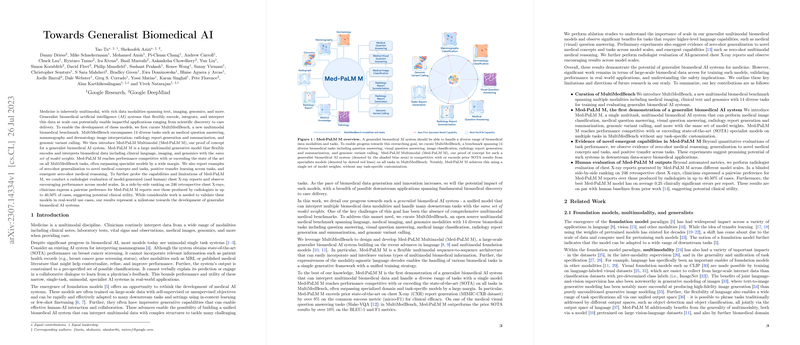Towards Generalist Biomedical AI: Overview and Implications
The paper "Towards Generalist Biomedical AI" presents a comprehensive approach to developing a generalist artificial intelligence system aimed at the biomedical field. The primary contribution is the introduction of the Med-PaLM Multimodal (Med-PaLM M) model, alongside the creation of MultiMedBench, a diverse multimodal biomedical benchmark. Med-PaLM M seeks to address the challenges posed by multimodal medical data, encompassing text, imaging, and genomics, by integrating and analyzing these modalities with a unified set of model weights.
MultiMedBench: A New Benchmark for Biomedical AI
MultiMedBench is curated to support the evaluation and training of generalist biomedical AI systems. It includes 14 tasks drawn from diverse biomedical domains such as medical question answering, image interpretation, radiology report summarization, and genomic variant calling. The tasks span multiple modalities, including clinical text, medical imaging, and genomics, providing a comprehensive framework for assessing the performance of multipurpose AI models in a clinical context. The benchmark's emphasis on both diversity and specificity in task design highlights its utility in enabling models capable of addressing the cross-domain demands of modern medical practice.
Med-PaLM Multimodal (Med-PaLM M)
Med-PaLM M is introduced as a proof-of-concept model demonstrating the potential of a unified AI system to handle a wide range of biomedical tasks. Utilizing a flexible sequence-to-sequence architecture, Med-PaLM M is built upon foundation models known for their successful deployment in large-scale language and multimodal tasks. This architecture allows Med-PaLM M to encode and integrate multimodal biomedical data seamlessly.
The paper reports that Med-PaLM M's performance is competitive with or exceeds current state-of-the-art (SOTA) models across the tasks encompassed by MultiMedBench. Specifically, it demonstrates significant advantages in tasks such as chest X-ray report generation, where it surpasses existing models by over 8% in clinical efficacy (micro-F1 metric) on the MIMIC-CXR dataset. These results exemplify the advantages of using a generalist approach to model training and hint at the potential for these systems to reduce model complexity and enhance real-world applicability.
Emergent Capabilities and Zero-Shot Generalization
One of the notable findings is Med-PaLM M's ability to perform zero-shot generalization to new medical concepts and tasks, leveraging cross-task learning and positive transfer. The paper presents cases where Med-PaLM M competently interprets novel inputs, such as detecting tuberculosis in chest X-rays, a task not specifically included in its training regimen. This emergent behavior underscores the potential of foundation models to extend their utility in unanticipated directions, contributing to their adaptability in fast-evolving fields like biomedicine.
Radiologist Evaluation of Model Outputs
The paper also details a clinician evaluation of Med-PaLM M's radiology report generation, using the MIMIC-CXR dataset. In side-by-side comparisons, clinicians preferred Med-PaLM M's generated reports over radiologist-authored ones in up to 40.50% of cases. Moreover, Med-PaLM M reports exhibited error rates comparable to human baselines, further suggesting its potential utility in clinical settings. This aspect of human-in-the-loop evaluation is crucial for validating AI models in healthcare, where safety and accuracy are paramount.
Implications and Future Directions
The insights provided by this paper have several implications for the future of AI in biomedicine:
- Scalability and Integration: The ability to integrate multiple data modalities through generalist models like Med-PaLM M can yield more comprehensive and efficient analytical tools, enhancing both the speed and accuracy of medical assessments.
- Data Limitations: The challenges associated with accessing large-scale multimodal medical data remain a critical bottleneck, as acknowledged in the paper. Future efforts must focus on data sharing initiatives and ethical considerations to amplify the potential of such AI systems.
- Generalist vs. Specialist Models: While Med-PaLM M demonstrates the efficacy of generalist approaches, the paper highlights that there will likely always be roles for highly specialized models in medical AI. A combination of generalist and specialist models could provide the best framework for improving patient care.
In conclusion, this paper represents a significant step towards creating comprehensive AI systems capable of proficiently managing the multifaceted data inherent in medical practice. Although further validation and continued development are required, the findings underscore the potential of novel AI architectures to revolutionize biomedical research and healthcare delivery.
